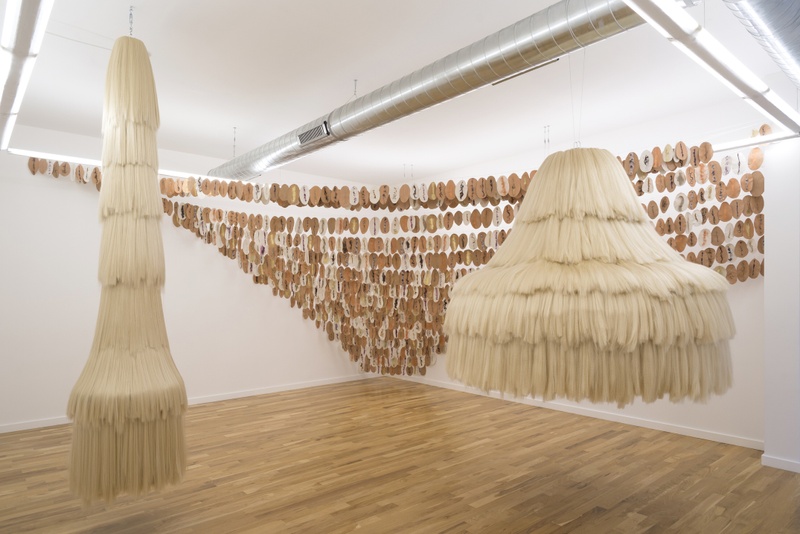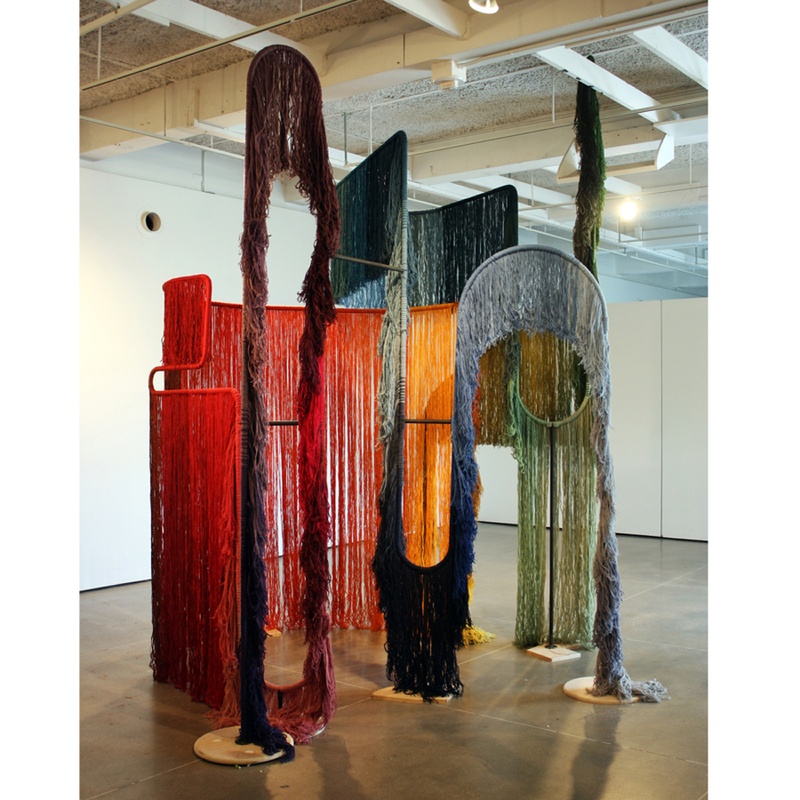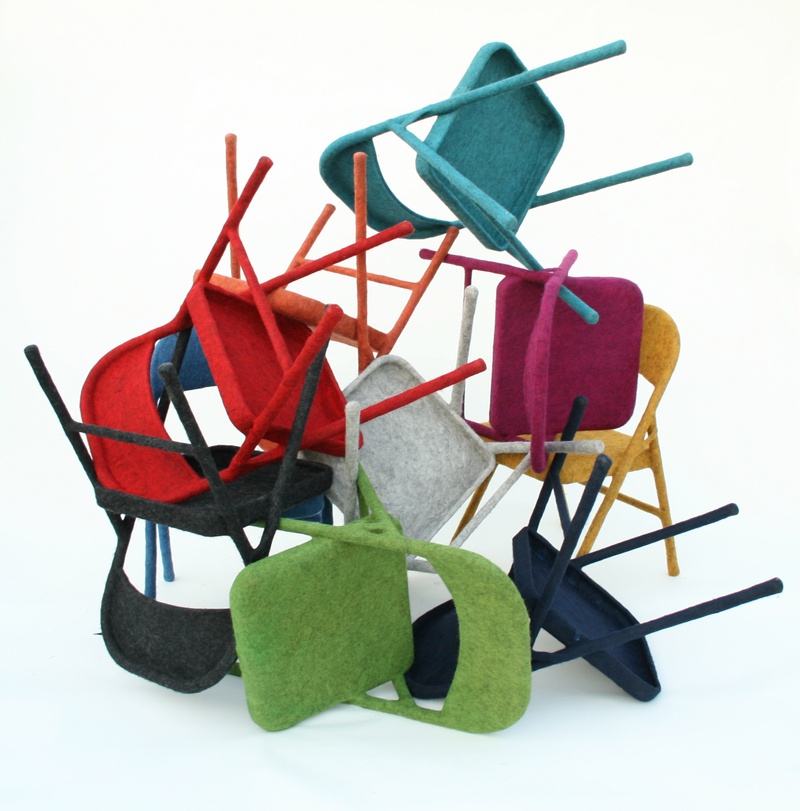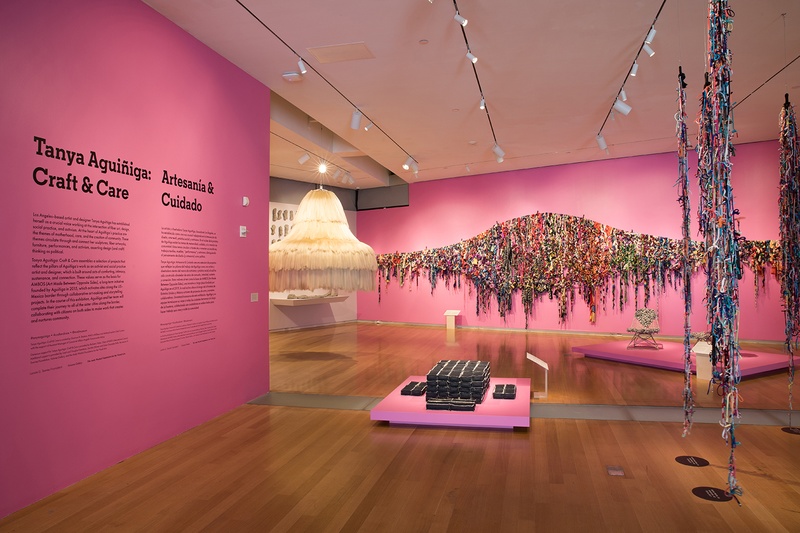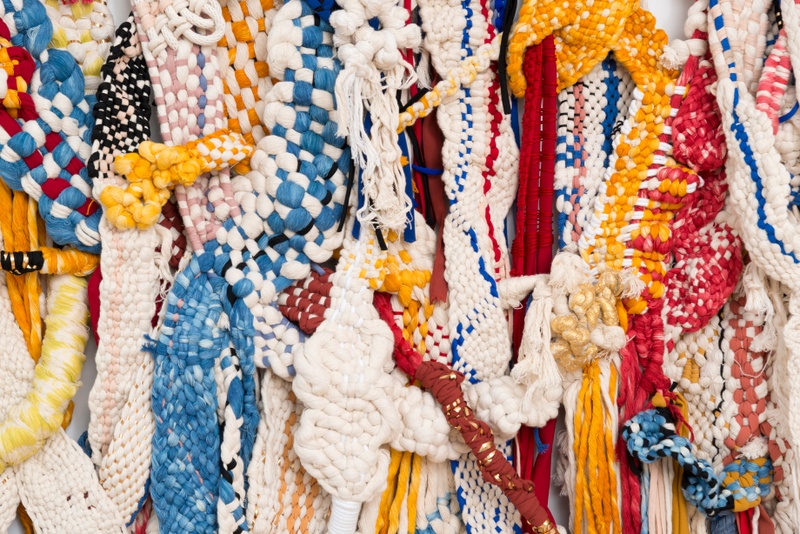Have your arts practice and activism always coexisted fluidly?
I used to have everything very separate. When I started doing community activism I felt like it was something that was right to do and something my whole life had led up to, because of feeling a massive amount of privilege for being able to cross the border every day when growing up in Tijuana. So it was something I did for my soul’s sake.
The work that’s more fine arts and design based, I did as a way to control the chaos in the world.</span> It was kind of a weird OCD therapy—a way of exercising the structure that school gave me. Growing up as a child of an alcoholic, a lot of us have really intense ways of controlling what we can through over-excelling. The art and design stuff was my way of squaring everything off. So I always had really defined outlets of art. They’ve been kept separate for my own sanity but have intertwined at different points in my life based on the political climate, the region I’m living in, and whatever’s going on in the world.
If somebody’s looking for an outlet to get involved in community activism but doesn’t know where to start, what kind of advice do you give?
There is a lot of tokenism that happens with anybody who is of a different class or has a different level of privilege and goes in to work with communities. Everybody has a public practice now. I think that going in like, “It’s something I think I should do,” complicates things and sometimes makes it so that people actually hurt communities more than help. So I would say that people should only get involved in helping community outside of themselves if it grows naturally out of their heart. It makes for a really unbalanced relationship if you don’t go delving into something you already love. Simple, small things that don’t feel like they have a lot of pressure to change the world is a good place to start.
Aguiniga Reindigenizing the Self Installation view Image courtesy of the artist and Volume Gallery, Chicago.
Can you exploit the desire of corporate entities, even if they’re coming from a place of tokenism, to do something positive with their funding?
Sadly I think a lot of us find ourselves in those situations and have to work out of financial need. So a lot of times, at least in our studio, we’ll have to take on a job with someone that maybe we don’t want to work with, really large brands or things like that. When we go into situations like that, we have a set of things we run through to make sure we’re not being taken advantage of. So that in the end, “selling out” for money doesn’t actually eat away at the studio—our mental health, our bodies’ abilities to deal with whatever trigger that client might’ve brought up.
Before we even get into working with anybody, we’ll talk to them about how open they are to true collaboration, because a lot of times I think large companies like to use us as tokens. It’s not just like, “I’m paying you to do this so you should just be happy to do it,” but it’s banking on your creative and cultural capital, which actually has a lot of value. So I think those situations need to be worked through so that you get to a place where you kind of level out the playing field and they get to understand that you actually have a lot of equity to bring to the conversation. Then we’ll work out ways where we become kind of agitators or instigators for good. When we look at what they’ve done before and it looks like they were being respectful or pushed the envelope to benefit a large number of people, that’s usually when we’ll start a conversation with them. Once we know what their intention is, we quickly move on to what we are allowed to do. What are the expectations and budgets? If one of those fall out, then we don’t do it.
You mentioned there’s a lot of authentic value in artists. Sometimes it’s hard for the artists themselves to feel that value if they’re looking at their bank statements. Is there any encouragement you like to give to young artists, a way for them to step back and understand their value?
People constantly think that I’m doing really well financially because I have so many exhibitions. But the art field is skewed in a really weird way where it doesn’t really take care of its own. It doesn’t account for the artist as a person. What’s valued are the objects, because that’s related to a commodity. And so I think understanding that it’s an ebb and flow is important, and that you have to have really amazing support from your community, friends, and family, so that you’re never alone. Make sure that you vocalize and ask your community for help. One of the greatest strengths I’ve learned over the years is the power of vulnerability and just being straight up honest about the realities of trying to make it as a person that didn’t come from money and doesn’t have money. Nobody’s going through that stuff alone. It happens to all of us regardless of how the public perceives our success. A lot of times I think we judge success based on finances, but success is really happiness and that doesn’t necessarily correlate with finances.
ShagCurves Image courtesy of the artist
There’s opportunity everywhere. It just kind of depends on knowing how to scale our needs to what we can actually access. I was doing a residency in Alaska and a lot of the traditional and native artists are really amazing at using every single part of everything that’s around naturally. I think there’s a lot of incredible innovation that comes out of need.
My use of material originally came from wanting to work with working class things that didn’t alienate my own family. I wanted to make things that could be understood, if it wasn’t in the conceptual way that I intended, then for the beauty of a material on a deeper generational level. So I tend to work with a lot of cotton and wool, because we’re constantly sheathed in these materials. It’s the things we grew up with, and what you got brought home in from the hospital.
For generations, people had to learn how to cultivate stuff, how to work it, how to figure out the different structures to make something stretchy, to make something stiff, to make something waterproof. There’s so many different things that I know our hands still remember. And so for me, a lot of it is just kind of tapping into weird magnetism of these really old-school ways of working that feel like they allow me in my studio practice and in my community-based work to kind of deconstruct hierarchies and talk to people about the magic of the stuff that is already inside of us.
You have a very close-knit studio. When you’re bringing someone into the fold, is there an important first step to get them into the DNA of the practice?
We just have to kind of vibe with the person and see some type of connection. We realized the studio works a lot better in terms of a weird symbiosis and melding of minds and hands when we don’t have straight men. Or, if a male or male-presenting person comes into the fold, they have to be incredibly feminist and empathetic. We’re really careful about allowing in any type of aggressive person because we do a lot of talking about our bodies and what women’s bodies go through. We do a lot of talking about problems in society that are related to patriarchy and a lot of real political talk that’s all about fighting for the rights of people of color, people that are indigenous, immigrants, people that are aging. We think a lot about everybody that’s been allowed to fall through the cracks for too long, and how we empower our brothers and sisters that are in those situations. So usually if a dude is not down with any of that, or if a dude gets grossed out by menstruation or something, that’s not a good fit for us.
How important is that constructive dialogue with your fellow artists to the actual final product?
I guess it depends on what the project is, because for some of them, we just kind of riff off each other—we’re just focused on each other, we’re not looking down at the thing that our hand is making. If we’re talking about something that we’re really heated about, then things will come up tighter. And if we’re talking about things that have to do with femininity or lactating or whatever, then a lot of times those things will come into the piece and we’ll end up with something that has a bunch of abstract boobs. And so, all of that stuff does always come in. It really informs the direction of the pieces a lot. We’ll be talking about intergenerational trauma and we’ll suddenly want to be ripping pieces so that you have gaping holes. So there’s a lot of stuff that comes into it that I think a lot of people kind of look past, at least in the fiber work, just because if it disguises itself as beautiful, then nobody thinks about the pain that went into it.
With the AMBOS Project, the relationship we were building with each other and the discoveries we were making within ourselves while being together—sometimes that feels more important than the physical work that we output, because I think it was such an intense, traumatic thing for a bunch of people, the same people, to go on for three years in a row.
Felt Folding Chairs Image courtesy of the artist
Can you explain what AMBOS is?
AMBOS stands for Art Made Between Opposite Sides. I founded the project in 2016 during the pre-election and started with activating the San Diego-Tijuana San Ysidro border crossing, and focusing on transnationals, the people that crossed the border every day to work, study, or shop in the US, which was what my family did. I crossed everyday for 14 years, my parents for over 40. My parents did it to go to work. I did it to go to school. A lot of issues in my life and in my parents’ life have been caused by making that commute every day.
And so originally, I wanted to focus on the transnational community and have this really amazing experience where for a month we had different artists come and collaborate with us from San Diego, Tijuana, and LA to talk about the rift between Chicanos, Mexican-Americans, and Mexicans, within the context of transnationality and the US and Mexico relationship where it converges at the border. And then after the first year, I had done a project called the Border Quipu where we gave every person that congregated at the border a postcard with two strings on it that said, “These two strings represent the relationship between the US and Mexico, our two selves at either side of the border and our mental state while crossing,” and it said, “Please make a knot.” And then on the back of it we asked people to write down a brief reflection of their thoughts on crossing the border or living at the border or being at the border.
After that, we realized the power of that project and got funding. It took us three years to complete the entirety of the US-Mexico border, traveling from Tijuana all the way to Brownsville and Matamoros. There was a core group of us that are educators, community activists, performance artists, documentarians, and photographers. We all would ride in this van together and zigzag and go to every single international border crossing between the US and Mexico, every single little town, and meet with artists at each of the sister cities—at every place that straddles the US-Mexico border through a port of entry—and talk to people about their main concerns in regards to the border. What artwork is made in each of those cities, how does it connect or not connect to the border, do they have any dialogue between their town and the town across the border?
So it was a lot of really deep, honest, painful conversations. In Arizona, there were a lot of white people that had never crossed the border, never taken the time to have interactions with people from the other side, yet made work about immigration or about the border. There’s a lot of nuances that happen over 2,500 miles of crazily changing terrain, going from ocean to desert to subtropical.
The first year on the road, there were seven of us. The second year there were eight. Everybody that comes along is also dealing with bi-nationality or the border. All of these people are exploring their own really deep identity to a place or a culture, whether it be the US and Mexico or a border or migration.
Someone in our group who’s a performance artist, she didn’t tell us before she became part of the group that she had actually walked to the US from Guatemala, when she was 17, and had attempted to cross on her own four times undocumented. And so it wasn’t until we got to the point where she had attempted to cross that a lot of stories and emotions and trauma and realization about all of these things that she hadn’t spoken to anybody about started to come out. So we all have really deep, complex connections to this subject. So yeah, it was a really weird journey. It was a lot of expanding our consciousness about what borders are.
Craft&Care-MAD-NY1 Photo by Jenna Bascom. Image courtesy of Museum of Arts and Design, New York
It seems that your work as an artist is therapeutic for yourself, your collaborators, and for the audiences engaging with it. Is there something you would like to share about this power of art?
Allow yourself to be vulnerable. Let other people into your journey. Try as much as possible while you’re making art to not judge yourself. I think that is really important. The sad thing is that with art there’s so many incredible things that we can do, in terms of helping ourselves psychologically, but once you put a price on it or show it to other people, it kind of moves into this different realm where I think a lot of our insecurities and anxieties start to come in.
So I think just remembering things are subjective, everything is an opinion, nothing is a truth, other than “this is made of canvas, this is made of ceramic.” We need to, as much as possible, not let people who say something negative keep us from continuing our exploration. Learn to let go a little bit and just do stuff for yourself. I think if you do stuff that you like, that’s when you get the farthest.
Chromatic 1, detail Courtesy of the artist and Volume Gallery, Chicago
Tanya Aguiñiga Recommends:
1: Mezcal and worm salt
2: Copal incense sticks
3: Korean spa
4: Spotting and gathering wild cochineal for pigments
5: Floating in the Sea of Cortez (preferably in Baja California South)
This content originally appeared on The Creative Independent and was authored by Mark "Frosty" Mcneill.
Mark "Frosty" Mcneill | Radio Free (2023-06-30T07:00:00+00:00) Artist Tanya Aguiñiga on the power of vulnerability. Retrieved from https://www.radiofree.org/2023/06/30/artist-tanya-aguiniga-on-the-power-of-vulnerability/
Please log in to upload a file.
There are no updates yet.
Click the Upload button above to add an update.
